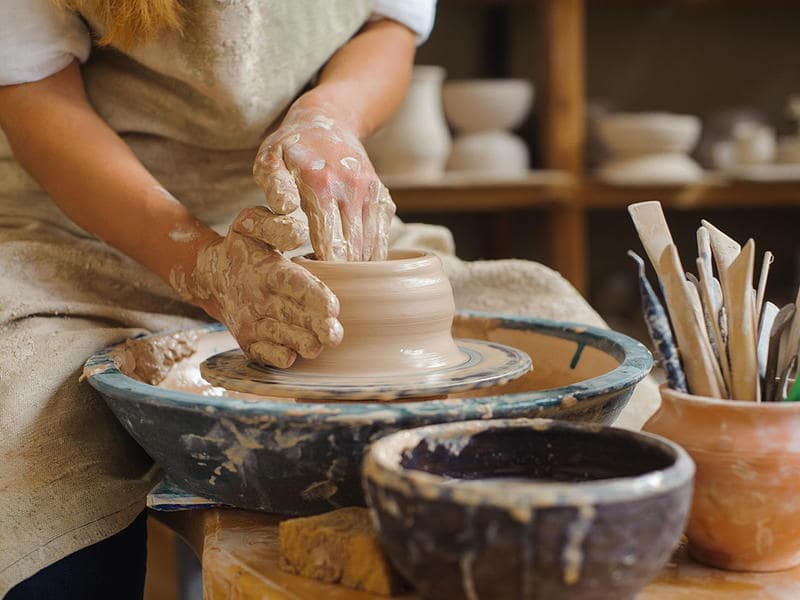Pottery is the art of making objects from baked clay. Clay is a sedimentary rock, constituted by aggregates of hydrated aluminum silicates, white when pure and varies in color according to the impurities it contains.
This art is one of the most important inventions of mankind. Being able to store and transport products, especially liquids, was a great revolution. As it is a lasting material, it is intimately related to the evolution of the human being, it can provide data about a certain people, degree of civilization, customs, religion, economy, commercial contacts. It serves as a testimony to know the characteristics of any culture. The use of the ceramics is very varied but we will focus the study in its use for the domestic furniture.
Etymology of ceramics
The term ceramics comes from the ancient Greek word “burnt substance”, which designated the neighborhood of the potters of ancient Athens, and is the art of making objects made from baked clay.
Origin of the ceramics
Some periods of our civilization, such as the Stone Age or the Bronze Age, were so named because of the importance of the use of certain materials and, therefore, it is striking that there is no period known as “The Ceramic Age”.
The ceramics is one of the oldest industries of the planet, its invention dates from the Neolithic period (Age of Polished Stone), 12,000 B.C. to 7,000 B.C., when the first containers to store food and water appear, although tests of the primitive elaboration of ceramics have been found in the Upper Palaeolithic, approximately in the year 24,000 B.C.

Characteristics of the ceramics
The properties of all materials are dictated by the types of atoms present, by the types of union of these atoms. The structure and the type of union tell us what kind of properties a certain material has, in our case the ceramic materials.
Ceramics usually have a combination of stronger bonds called ionic (occurs between a metal and non metal and involves the attraction of opposite charges when electrons are transferred from metal to non metal); and covalent. The strength of an ion bond depends on the size of the charge on each ion and the radius of each ion.
The greater the number of shared electrons, the greater the force of attraction, or the stronger the covalent bond.
These types of bonds produce a high level of elasticity and hardness, high melting points, low thermal expansion and good chemical resistance. On the other hand, ceramics are also hard and often fragile, which leads to fracture.
Techniques for obtaining ceramics
To obtain pieces of great resistance the clay must be submitted to different processes such as moulding, drying and firing.
In its origins the ceramics were modeled by hand, with different techniques like the pinch (first a clay ball is made, then it is pressed with the thumb from the center of the ball, with the other fingers on the outside. We squeeze the edges, slowly, to narrow the walls. Then we create the shape we want.
The colombin (long clay rolls of about the thickness of your thumb are used. A mass is formed that is squeezed, from the center towards the ends, turning with the palms of the hand. Then we use a circular base of clay and add the rolls to it).
The plate or iron (starting from a piece of clay we apply a pressure using a roller, then we cut the different pieces, taking into account their humidity so that we can join them, we reinforce the joints with a clay cord that we will weld with a barbotine).
Stages in the manufacture of ceramics
Extraction
The extraction of the clay is carried out in the quarries, known as drills, in the open air, under strict environmental and safety controls.
Milling
It is made to crumble the clay until the desired granulometry is obtained and it can be easily worked. It can be done dry or wet.
Mixing
The clay is mixed with water, in the right proportions, and stones and sand that may be contained are extracted.
Maturation
After two weeks the clay is ready for handling. It seems more ductile, more pleasant to the touch.
Modeling
In the past, the clay was rolled and knotted by hand. Nowadays, the modeling is done with machines, known as galleteras.
Cut
The cutters give shape to the ceramic pieces before they go into the firing ovens.
Drying
The freshly cut pieces must be dried before being cooked. To eliminate the water, the piece is left to dry for 24 hours.
Cooking
The clay is subjected to high temperatures to achieve a great consistency and durability.
Types of clay
Due to the use to which the clays are destined we can classify them in two groups:
Pottery clays
Also known as red clay, it has a great finish and is suitable for turning.
Terracotta
is the clay modeled and hardened in the oven, is used both to make containers, such as sculptures. It is porous and of great plasticity, reddish color.
Clay for earthenware
Its color varies from dark gray to white. They are very porous plastic clays.
Clay for Stoneware
It is very little porous, resists high temperatures and depending on the composition of clay its plasticity varies.
Clay for Porcelain
Ceramics made of kaolin, feldspar and quartz, white in color and not very resistant when dry.

